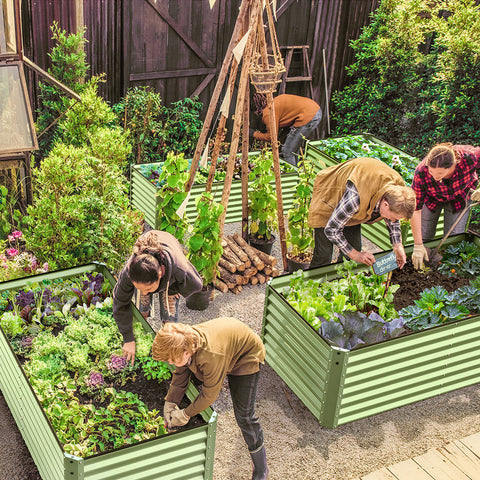Sunlight, water and soil are key components of a healthy plant. The light in your yard will change throughout the day as the shadows of buildings and tall plants move with the sun. Most plants can thrive in at least 6 hours of direct sunlight, which is often referred to as full sunlight. However, many plants will produce beautiful leaves and flowers with less sunlight, so you can still create a lush and colorful garden in the darkest of conditions. Here's what you need to do to make the most of every light level in the landscape. The following content also has some reference value for raised garden beds.
Study the sunlight in the yard
First, take the time to create a garden journal, where you can keep track of how much sunlight your yard receives over a period of time. Over the course of the day, assess the light patterns every hour or two, noting where the shadows fall and how long they last. Keep in mind that bare branches may give the illusion of sunshine in the spring, but once they lose their leaves, they can create heavy shadows in the summer and fall. Buildings and walls also cast shadows, so be sure to consider these structures when you're plotting the sun's path across the Earth.

You can use marker flags or stakes to indicate light and shadow in the yard, or you can draw a light map on paper. Start with a few sheets of tracing paper and sketch the outline of your yard on each page. About two hours after sunrise, observe where the light and shade fall and mark it on tracing paper with the time. Repeat the process throughout the day, using a different paper each time. Stop recording about an hour before dusk. Mark the inconspicuous places on each page with a pencil. Mark the sun and shadow pockets to indicate that they reflect morning or afternoon conditions. Stack these pieces of paper together and you'll know exactly how much light your yard receives.
Areas that receive sunlight almost all day are easy to deal with when designing a garden and choosing plants. You can count on the intensity of sunlight to vary slightly depending on the time of day, with softer light in the morning and more intense sunlight in the afternoon.
Shadows are a little more complicated. You can find a deep shade on the north side of the house, next to a stone wall or privacy fence, or under a 70-year-old beech tree, where there is only winter to early spring sunlight. Pair these shady spots with plants that don't need direct sunlight to grow.
Dappled shade can be found beneath the trees, where small leaves filter sunlight and cast a moving light. Deciduous trees, such as maples and ash trees, provide seasonal shade, thinning out at first, then filling the dense canopy to provide decent shade throughout the summer months. Leafless branches provide the perfect setting for ephemeral plants, such as bleeding hearts or naturalized spring bulbs, which are displayed at early-season flower shows and then quietly disappear as the canopy fills in and the shade deepens. When the sun passes overhead, the shadow pattern under deciduous trees changes and shortens during the summer, then lengthens as summer moves into fall. These seasonal light patterns help inform your choice and placement of plants for your garden.

In woodland Settings, tall trees often cast bright shadows, punctuated by beams of sunlight. In this case, it's a good idea to choose a reliable shade shade, such as a bride, to brighten a shady garden with colorful flowers. To create a lasting flower show, plant a mix of astillas that bloom in different seasons. Good companion plants to Rochingfeng include hakata grass, goat hair, hostas, and several ferns.
Consideration of regional impact
Across the United States, the light needs of plants are changing. In the hot South, sun-loving plants can benefit from shade during the hottest part of the day. Meanwhile, in the Pacific Northwest, cloud cover will keep sun lovers from thriving. In places where cool, wet summers prevail, plants that nominally prefer partial shade can thrive in sunny conditions.
Know your plant's light needs
Most plants have optimal light conditions, which are usually described as full sun, partial sun, partial shade, or full shade. Not sure what these terms mean? You're not alone. Here's how to crack the light code:
Full sun: Plants that need at least 6 hours of direct sunlight a day.
Partial sun/partial shade: These terms usually mean the same thing and refer to plants that should receive 3-6 hours of sun per day, preferably in the morning or evening. The rest of the time, the plants can be completely in shadow or in dappled shade.
Full shade: Plants that need less than three hours of direct sunlight per day. This can describe conditions on the north side of a building or under a shade tree, where sunlight briefly penetrates the canopy at some point during the day.
Try to get rid of some shadows
When planning your landscape, it's important to remember that many things - including the light available - are flexible. If you have a tree and the branches cast thick shadows, light up the area below by removing the lower limbs. This process, known as limbing up, effectively lifts the tree canopy to allow more sunlight to reach below. In late summer and autumn, sunlight can beam out from under thickly branched trees, illuminating deep shadows. Selective thinning can increase ground light. Similarly, you might consider replacing a sturdy fence with a vine-covered lattice for added light.

Remember, rules are flexible
Once you know the sun and shade characteristics of your garden, it's time to start picking out plants. Keep in mind that if you happen to put a plant somewhere with too much or too little light, you won't necessarily kill it right away. You may experience early warning signs, such as fewer flowers, a short life span, less color, or long stems. If an annual or perennial isn't growing well in one spot, grab a shovel and transplant it to another. Plants are tough; They can usually cope with moving from one place to another.
Q&A
How much light do my flowers need per day?
The amount of light your flowers need depends on the species, but there are some hypothetical guidelines you can follow. In general, most (but not all) flowering plants need at least eight to 10 hours of sunlight a day to produce their most vibrant and abundant flowers.
What flowers grow well in shady places?
While most flowers need full sunlight to thrive, several flowers can grow and bloom successfully in shady or partially shaded areas. Some of the most popular choices include bloodheart, lungweed, hellebore, begonia, and impatiens.









